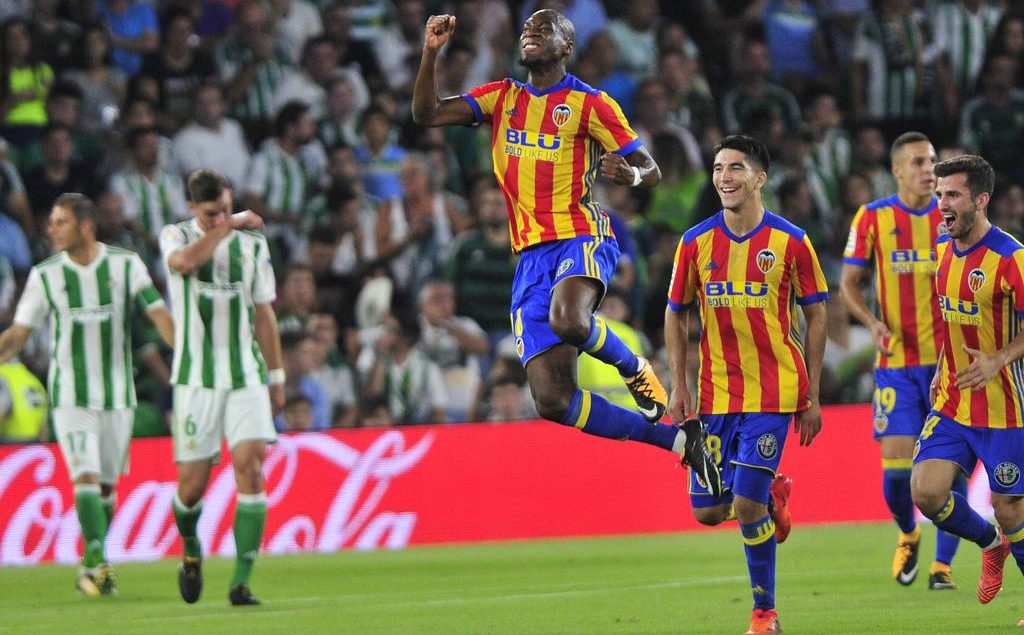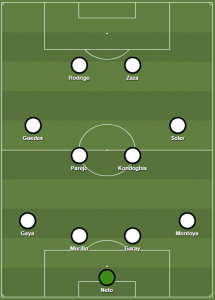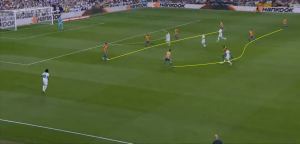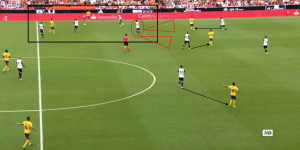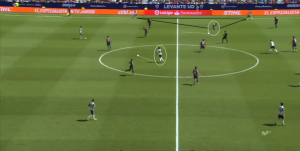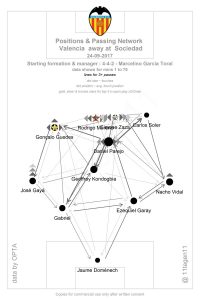The rebirth of Valencia CF
With a restructured squad, ambition and exemplary performances, Valencia have finally returned to winning days.
For several years now, the emblematic team of eastern Spain struggled to achieve something at the highest level, seeming content to play a secondary role, or even a tertiary role, playing to remain in La Liga.
Excluded from the brilliant Spanish trio of both Madrid teams and Barcelona on the European stage, “Los Blanquinegros” played side-by-side against the other national outsiders, including Sevilla, Bilbao and Villarreal.
But since the beginning of the season, the phoenix has been reborn from the ashes, sticking close to Barcelona in second place, all while putting in incredible, spell-binding performances. (Ex: 4-0 against Sevilla)
How did Marcelino put Peter Lim’s club back on track? Let’s take a look.
The formation
As a manager joins a new team, many squad changes can be expected. The manager must clean out the unnecessary, ineffective players and form a solid base.
In Valencia, Marcelino was tasked with managing a large wave of departures (23), including important players like Alvaro Negredo, Enzo Perez & Diego Alves. Nevertheless, he decided to reinstate the famous formation that earned him his reputation on the national and European scene, the 4-4-2. Here’s why:
https://www.twitter.com/AlbertOrtegaES1/status/928252616030769152
For a team that wishes to defend in a compact system, and counter rapidly, the 4-4-2 is the most suitable formation.
This system improves the balance of the team and allows for very fast transitions between the defensive and offensive stages (eg. Real Madrid with Carlo Ancelotti).
It’s not a closed system; it remains open to all profiles, as can be seen from this Valencia side. Let’s take a look at 3 players who illustrate this.
“The warrior”, Simone Zaza:
On the front line, one player had everything to prove early in the season: Simone Zaza. Considered one of Italy’s greatest prodigies with Sassuolo, the Italian international is now back at the top of his game, after numerous sporting disappointments (passing through several clubs with barely any playing time, as well as a missed penalty against Germany at the Euros).
With a look worthy of the tv show “Gomorra”, Simone Zaza is a real killer in the box, thanks to his excellent aerial game, and a left foot on fire at every opportunity to shoot. On top of that, his playing style (back towards goal) allows his teammates to rely on him as a focal point of attack, and he often deceives opponents with his speed.
Zaza is currently the 2nd best goal scorer in La Liga, leaving his mark on Spain, and the Azzurri have taken notice. After several months without a call-up, Gian Piero Ventura called up Zaza to Italy’s senior squad, against November’s play-offs against Sweden. “I am very happy. It’s a prize for me but also for the team. Without the team, nothing would be possible. Messi can do it alone, but without the team, I wouldn’t win anything. Now, I hope to continue like this and score in October,” Zaza said after his nomination as the best Liga player of the month of September.
https://www.youtube.com/watch?v=fke_WepqyDI
The new Cristiano, Gonçalo Guedes
While some teams are struggling to attract young prodigies worldwide, Valencia fans need not search: they have Gonçalo Guedes. After leaving on loan from PSG in the final hours of the transfer window, the former Benfica player is currently shining in black and white.
With consistent playing time, he can finally show all his qualities and claim a place for the 2018 World Cup in Russia, with Portugal (4 caps).
Able to play at every offensive position, Marcelino decided to position him on the left flank of his 4-4-2.
The Portuguese striker is like a Swiss army knife at this position: he can defeat his fullback in a 1v1 duel like a true winger, create the final pass for his teammates to convert, and finish an opportunity like a killer. He is a complete dynamo.
https://twitter.com/FussballRadars/status/929432515693174784
Author of 3 goals and 5 assists, this young man, 20, has done well enough this season to make the president of Valencia think about his future in Valencia:
“Guedes is a great player who will be with us this season. After that, the transfer window will open and we need to work on it again.”
https://www.youtube.com/watch?v=rfHFOsqo8kc
The rebirth of Geoffrey Kondogbia :
“Cats always land on their feet,” is the expression that could best illustrate the situation of our third player. After two poor seasons in Italy, the French international decided to start over in Spain.
After Valencia took the weight off his shoulders (biggest transfer in Inter’s history), the French midfielder has rediscovered his best form on this Valencia side. Impressive performances, high technical quality and tactical intelligence: the former Monaco player has become an essential element in Valencia’s system.
Thanks to his chemistry with Dani Parejo, he is the best possible player to guard the defense and organize the midfield, as the technical leader of the team. If he continues at this level, Deschamps will have even more of a selection headache at his hands.
https://www.youtube.com/watch?v=HqW9dBsLYeg
If you look closely, Valencia has a starting 11 teeming with youth, talent and experience. Players such as Garay or Parejo know how to handle the tough moments of a match, while Soler or Gaya use their youthful fire to explode past defenses. With this mixture, Marcelino can put together a fierce title challenge, as Valencia aim to return to not only Spain’s helm, but Europe’s as well.
Defensive phases and players involved
“First of all, you must close the front door. If you do not close the door, burglars will come in and steal everything. Once it is shut, you can decorate and organize as you wish.”-Claudio Ranieri
Having conceded 65 goals last season, Marcelino arrived in Valencia with a huge priority: to turn a weak defense into one of the strongest in the country. The former Villarreal tactician worked his magic, turning Valencia into a defensive stalwart once again. With a 4-4-2, the players create superiority on the wings, adding to Los Murciélagos’ defensive solidity.
Positioned in a central block, the two lines of 4 are positioned perfectly to defend, reducing spaces in midfield to drive forward in. Thanks to the formation of this mobile and compact team, the opponent has only one choice: find a solution on the opposite wing to force the “Blanquinegros” to shift.
This image proves what Valencia is capable of doing. With their double flanks and the help of one of the attackers, the Atlético players are outnumbered 2 v 4 in a small space. The goal is to lock the opponent against the line. By doing this, Valencia’s numerical majority forces Atlético into losing the ball.
To prevent further play forward, Parejo blocks off the pass lane, positioning himself perfectly to force Filipe Luís to play backwards. It is the opposite player, Andreas Pereira that day, which compensates for Parejo’s shift to the right by tucking inwards. With this configuration, Marcelino does not ask his team to constantly press and harass the central defenders, but instead, block off passing lanes in midfield.
The main goal is to lock the opponent up with help from the wingers; With Valencia’s individual quality, creating is never an issue. But Marcelino knows better than anyone that defending is not a basic idea, but an array of different tactical plans. It is of utmost necessity to bring a variety with a higher block on the pitch and pressing at key moments.
With players like Rodrigo and Zaza, Marcelino can count on two players who have the desire and will to help their team regain possession as soon as they lose it. The pressing is well organized, as the work of the two attackers allows the block to remain solid and mobile. Zaza and Rodrigo remain high on the pitch, assured in making the right pressing movement.
With the different sequences previously explained, we realize that Valencia has several defensive formations. To get his players in tune with these defensive formations, Marcelino prepares his players for the physical tasks of the required off-the-ball work.
Kondogbia is the ideal reference to for Valencia off-the-ball work. When we look at the number of balls recovered, the former Sevilla player has a superb work rate and a cunning ability to regain possession, making him one of the best defensive midfielders in La Liga.
With such high defensive ambitions, one can expect some spectacular ideas with the ball.
The art of controlling the ball and the 4-4-2 formation
At a time where tactical variations are more important than ever, Marcelino decided to use a formation that was considered a “has-been” for coaches over the years, and remained dogmatic in his choice.
“From the first day, I said to myself: this guy knows football. The way he spoke, the way we trained, these training sessions were not only about conditioning but it also made you think, you always have to be focused with him,” Dani Parejo said about Marcelino.
If we compare this system to a 3-4-3 for example, it doesn’t allow them to make triangles to create a choice of pass variations: a one-two, looking for the 3rd man. As a result, it is necessary for players to get out of their initial zones to create these phases of play and make the 4-4-2 adjustable.
This sequence shows the risk-taking and the technical quality of Marcelino’s teams. While the central defenders go wide to stretch the defensive block and create space amidst the opposition’s press, Neto makes the decision to quickly release the ball with a square pass thanks to Kondogbia’s movement between the lines. Always well positioned next to his teammates, the French international takes the initiative to play forward despite the pressure of the other team: this offers a solution to Guedes to find a free player forward.
While teams often refer to lateral play, horizontal passes, and quick diagonals when they want to unbalance the block and shift the opposition’s press, Marcelino wants players to seek verticality as soon as possible in order to unbalance the opponent quickly.
This sequence represents it perfectly. During this phase of offensive/defensive transition from Sevilla, we see Kondogbia, without hesitation, passing the ball from a crowded midfield area to a free space, where Jeison Murillo has time on the ball.
Then, Murillo is in the best possible condition to take the risk that follows, breaking the lines with a vertical pass and instigating the attack.
Murillo’s pass was risky, but it paid off in the end. This pass eliminates the first line of pressure, making Sevilla’s defensive structure vulnerable, and allowing Guedes to finish with a delightful sprint and golazo.
When we see the different movements in midfield, we notice that the initial problem about not being able to create triangles will quickly be resolved. Parejo and Kondogbia do not hesitate to step out of their initial space to allow the wingers to move higher on the pitch.
By allowing them to be more creative in midfield, as they are accustomed to, Marcelino improves not only the fluidity of the build-up but the creativity, owing to the pivot’s smart, adventuresome decision-making.
The most noticeable thing about this Valencia team is the ability of the attacking players to play with their back towards goal. This makes it possible to have more than one option to pass the ball, and not only target man Simone Zaza, who excels in holding up possession.
In this sequence, we see a double support–passing options both forward and sideways, forcing the opponents to advance further in their press, and creating passing extra lanes in build-up.
Thanks to the presence of the wingers on the field, Valencia can afford to combine in small spaces and play wide. With this quality in these offensive players, Marcelino has made these spacing orientations the blueprint of his team, and he has not hesitated to use it elsewhere on the pitch.
If the players are in motion, this type of sequence can be very effective, even though it may seem simple at first. With their well-tuned 4-4-2, Valencia is not just an exclusively strong team in transition defense/offense, but also amazing going forward.
With experienced players in midfield, Valencia has the opportunity to “place the ball” and show its technical quality in attack. Being the technical leader, we see that Dani Parejo is not aligned on this pass map against the Sociedad.
He is able to steer the game and make a final vertical pass to put his striker in the best possible condition to convert in front of goal.
And behind him, Kondogbia does not complain when doing the work ‘behind the scenes’ (not like some in France) to allow the former Getafe player freedom on the ball. But despite his relentless work rate, the Frenchman also does not hesitate to take the ball with him, as we can see against Real Madrid:
As for the eccentric players, their in-game intelligence and their intrinsic chemistry have played a significant part in Valencia’s success since the beginning of the season. Along with the wingers, Guedes and Soler (or Pereira), they don’t hesitate to slow down the game by passing backwards to find a player between the lines.
Behind them, Garay and Montoya have gained a new lease on life with Marcelino. They constantly participate in different attacks thanks to the fact that they are placed high on the pitch, as indicated by the pass map. In addition, they are players who are superb crossers, allowing them to find openings in the final third.
If we look at the statistics of the starters, they average 12 crosses per game, with a 79% success rate. And again, this is not the strongest part of the team’s attack.
With an average of 48.3% possession since the beginning of the season, Valencia is a team that represents Marcelino’s ideas: they look for verticality as soon as possible, and play on the intrinsic qualities of the defensive-offensive transition phases.
No need to comment, we just need to admire and applaud. With the co-best attack of La Liga (30 goals like Barcelona), Valencia is shining on the table, and has finally returned to the highest level. Capable of varying its game plan based on the opponent, this team showcases its brilliance regardless of the opponents.
Currently four points behind Barcelona in 2nd place, Valencia demonstrates that with an ambitious coach, you can revolutionize a team that was in trouble a few months back. Having a complete squad with different profiles in each position, Valencia have reaped the rewards of a solid tactical blueprint and a complete squad.
If the first three months of the season are any indication, Marcelino will surprise the skeptics who claimed that Valencia would crack before the end of the season. In any case, the Spanish coach can take this team very far, perhaps even the heights Valencia reached in the start of the millennium. We may have the surprise of the season right here..
By: @CharafMD8
Translated by: @Leahvdc2
Photo: Imago
